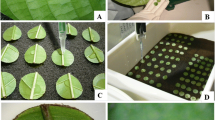Abstract
Ninety six genotypes, including 14 cultivars, of Trifolium subterraneum var. subterraneum and var. yanninicum were screened in the field for resistance to Cercospora (Cercospora zebrina). Seven genotypes, 84S43-13, 84S43-15, EP132Sub-E, 84Y32-59, 83Y83-23, 84Y32-42 and 83Y79-20, were totally resistant to Cercospora disease. A further 26 genotypes, including the cvv. Meteora and Napier, had an incidence of Cercospora of <1 (0–10 scale) and no consequent leaf collapse from the disease (score 0; 0-10 scale), while 15 genotypes had incidence scores between 1 and 2 without any leaf collapse evident. There was excellent overall correlation between Cercospora incidence and leaf collapse across the genotypes tested, with both strong quadratic (y = -0.17x 2 + 2.50x + 1.33; R 2 =0.89) and linear (y = 0.96x+ 1.63; R 2 =0.82) components to this relationship. There was circumstantial evidence of ecogeographical differences for Cercospora resistance among ecotypes collected from different regions. Of eight overseas introductions with Cercospora incidence scores of <2 and a Cercospora leaf collapse score of 0, six were from Sardinia and one each were from Portugal and Greece. In contrast, all seven Sicilian ecotypes had Cercospora incidence scores of 7.75 or greater. The high degree of resistance observed in many of the genotypes to Cercospora highlights the existence of many exce llent sources of resistance that could be exploited in breeding and development programmes to minimise production losses in Australian subterranean clover pastures.
Similar content being viewed by others
References
Anon. (1964) Diseases of clovers in New South Wales. Agricultural Gazette of New South Wales 75, 1204–1211.
Anon. (1975) Clover diseases in New South Wales. New South Wales Department of Agriculture, Biology Branch, Plant Disease Bulletin No. 155.
Barbetti MJ (1983) Fungal foliage diseases of pasture legumes. Journal of Agriculture, Western Australia1, 10–12.
Barbetti MJ (1985) Infection studies with Cercospora zebrina on pasture legumes in Western Australia. Australian Journal of Experimental Agriculture25, 850–855.
Barbetti MJ (1987a) Effects of three foliar diseases on biomass and seed yield for 11 cultivars of subterranean clover. Plant Disease71, 350–353.
Barbetti MJ (1987b) Evaluation of fungicides for control of Cercospora zebrina on subterranean clover. Australian Journal of Experimental Agriculture27, 107–111.
Barbetti MJ (1987c) Seasonal fluctuations in concentrations of airborne conidia of Cercospora zebrina and incidence of Cercospora disease in subterrnanean clover. Transactions of the British Mycological Society88, 280–283.
Barbetti MJ (1991) Response of subterranean clover varieties to Cercospora disease under a controlled environment and in the field. Australian Journal of Experimental Agriculture31, 333–336.
Barbetti MJ, Nichols PGH (1994) Field resistance in Trifolium subterraneum to Uromyces trifolii-repentis and Cercospora zebrina. Australian Journal of Experimental Agriculture34, 1131–1136.
Baxter JW (1955) Diseases of forage legumes in Iowa in 1954. Plant Disease Reporter39, 239.
Baxter JW (1956) Cercospora blackstem of alfalfa. Phytopathology46, 398–400.
Berger RD (1962) Factors affecting growth, sporulation, pathogencity and survival of Cercospora zebrina. Dissertation Abstracts23, 1155.
Berger RD, Hanson EW (1963) Relation of environmental factors to growth and sporulation of Cercospora zebrina. Phytopathology53, 286–294.
Bokor A (1983) Cercospora zebrina found on Trifolium subterraneum L. in Western Australia. Australasian Plant Pathology12, 24.
Gladstones JS (1975) Legumes and Australian agriculture. Farrer Memorial Oration, 1975. Journal of the Australian Institute of Agricultural Science41, 227–240.
Hanson EW (1953) Relative prevalence and severity of the diseases of forage legumes in Wisconsin 1946–1952. Plant Disease Reporter37, 467–472.
Pratt RG (1984) A new Cercospora leaf and stem disease ofsubterranean clover. Phytopathology74, 1152–1156.
Pratt RG (1987) Effects of Cercospora leaf disease on seed production of subterranean clover. (Abstr). Phytopathology11, 1707.
Pratt RG (1989) Relationships of infection by Cercospora zebrina to seed production and seed quality of subterranean clover. Phytopathology79, 209–213.
Valder PG (1954) Diseases of clovers in New South Wales. Agricultural Gazette of New South Wales65, 465–471.
Author information
Authors and Affiliations
Corresponding author
Rights and permissions
About this article
Cite this article
Barbe, M.J., Nichols, P.G.H. Field performance of subterranean clover germplasm in relation to severity of Cercospora disease. Australasian Plant Pathology 34, 197–201 (2005). https://doi.org/10.1071/AP05017
Received:
Accepted:
Published:
Issue Date:
DOI: https://doi.org/10.1071/AP05017




